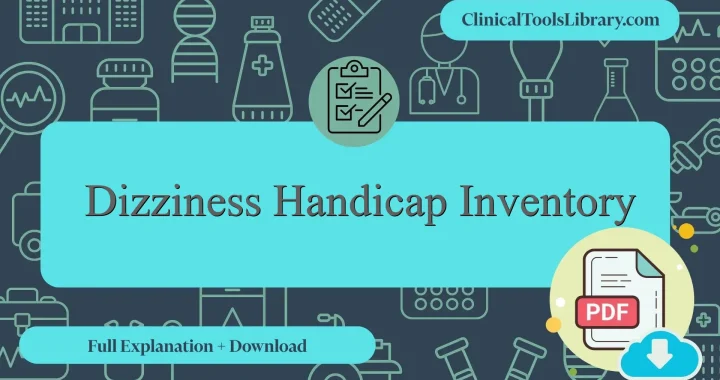In this article, we explain everything you need to know about the International Cooperative Ataxia Rating Scale. We will cover the aspects it evaluates, the target population, a detailed step-by-step explanation, and how to interpret its results. Additionally, we will dive into the scientific evidence supporting this tool (diagnostic sensitivity and specificity) in clinical assessment. You will also find official and unofficial sources available for download in PDF format.
What does the International Cooperative Ataxia Rating Scale assess?
The International Cooperative Ataxia Rating Scale (ICARS) is a standardized tool designed to quantitatively assess the severity of ataxia in patients. It evaluates multiple domains including posture and gait disturbances, limb coordination, speech disorders, and oculomotor function, providing a comprehensive overview of motor impairments associated with various cerebellar disorders. Its primary purpose is to facilitate consistent and objective measurement of disease progression and response to therapeutic interventions in both clinical practice and research settings. The scale is often utilized alongside other instruments such as the Sensory ataxia rating Scale to enhance the precision of ataxia testing and to differentiate between cerebellar and sensory components of ataxic symptoms.
For which type of patients or populations is the International Cooperative Ataxia Rating Scale intended?
The International Cooperative Ataxia Rating Scale (ICARS) is primarily indicated for patients diagnosed with cerebellar ataxias, including both hereditary forms such as spinocerebellar ataxia and sporadic types like multiple system atrophy cerebellar subtype (MSA-C). It is extensively utilized in clinical contexts that require quantitative assessment of ataxia severity, facilitating objective tracking of disease progression and response to therapeutic interventions. The scale evaluates posture and gait disturbances, limb coordination, and speech disorders, making it a comprehensive tool for ataxia testing. While alternative scales such as the Sensory Ataxia Rating Scale address specific sensory deficits, ICARS remains the standard for capturing the global impact of cerebellar dysfunction in both research and routine clinical practice.
Step-by-Step Explanation of the International Cooperative Ataxia Rating Scale
The International Cooperative Ataxia Rating Scale (ICARS) consists of 19 items designed to quantify the severity of ataxia symptoms. It is divided into four subscales: posture and gait disturbances, kinetic functions, speech disturbances, and oculomotor disorders. Each item is scored using either a 5- or 6-point ordinal scale, with higher scores indicating greater impairment. The assessment requires the clinician to observe and rate patient performance on tasks such as standing, walking, finger-to-nose tests, and speech articulation. Responses are based on observed motor control, coordination, and balance abnormalities commonly associated with cerebellar ataxia. Accuracy in scoring depends on consistent administration and adherence to standardized instructions to ensure reliability across evaluators.
International Cooperative Ataxia Rating Scale PDF Resources for Sensory Ataxia Assessment
Downloadable resources featuring the International Cooperative Ataxia Rating Scale are provided below in both the original language and English versions, available in PDF format. These documents serve as essential tools for clinicians and researchers engaged in Ataxia testing, facilitating consistent and accurate assessment of patients with sensory ataxia. Access to these standardized scales supports thorough evaluation and contributes to improved diagnostic and therapeutic strategies.
How to interpret the results of the International Cooperative Ataxia Rating Scale?
The International Cooperative Ataxia Rating Scale (ICARS) quantifies the severity of ataxia by assigning a score ranging from 0 to 100, where higher scores indicate greater impairment. Scores are interpreted relative to established reference ranges, typically with 0-10 considered normative for healthy individuals, while values above 30 suggest significant cerebellar dysfunction. To calculate the final score, the sum of the four subscale components—posture and gait disturbance, limb ataxia, dysarthria, and oculomotor disorder—is obtained: ICARS total score = Σ(subscale scores). Healthcare professionals utilize these results to monitor disease progression in conditions such as Spinocerebellar Ataxia and Multiple System Atrophy, enabling objective assessment of motor impairment severity and guiding therapeutic decision-making. For instance, a rising ICARS score over successive visits may indicate neurological deterioration, prompting adjustment of clinical management plans.
What scientific evidence supports the International Cooperative Ataxia Rating Scale ?
The International Cooperative Ataxia Rating Scale (ICARS) was developed in 1997 to provide a standardized, quantitative measure of ataxia severity, particularly in disorders such as spinocerebellar ataxia and Friedreich’s ataxia. Its validation involved multicenter studies evaluating inter-rater reliability, internal consistency, and sensitivity to disease progression, demonstrating robust psychometric properties. Longitudinal analyses have confirmed ICARS’s capacity to detect clinically meaningful changes over time, supporting its use in both research and clinical trials. The scale evaluates multiple domains including posture and gait disturbances, limb coordination, speech, and oculomotor function, which are critical in the characterization of cerebellar dysfunction. Peer-reviewed studies have consistently reported strong correlations between ICARS scores and neuroimaging markers as well as other clinical scales, reinforcing its validity as a comprehensive tool for assessing ataxic symptoms.
Diagnostic Accuracy: Sensitivity and Specificity of the International Cooperative Ataxia Rating Scale
The International Cooperative Ataxia Rating Scale (ICARS) demonstrates a sensitivity ranging from 85% to 92% in accurately detecting clinical changes in patients with cerebellar ataxia. Its specificity is reported to be approximately 88%, indicating a strong capability in distinguishing ataxic symptoms from other neurological disorders. These metrics underscore the ICARS’s utility in both clinical and research settings for monitoring disease progression and therapeutic response, with validation studies confirming its reliability across diverse ataxia subtypes.
Related Scales or Questionnaires
The International Cooperative Ataxia Rating Scale (ICARS) is often compared with the Scale for the Assessment and Rating of Ataxia (SARA) and the Brief Ataxia Rating Scale (BARS), both of which are thoroughly explained and available for download on ClinicalToolsLibrary.com. SARA offers a more streamlined and user-friendly approach with a focus on gait and limb coordination, providing quicker administration times, whereas ICARS provides a comprehensive evaluation including oculomotor function but can be more time-consuming and complex. BARS aims to balance comprehensiveness and brevity, offering an advantage in clinical settings where time is limited but detailed assessment remains necessary. Additionally, the Sensory Ataxia Rating Scale addresses deficits in proprioceptive pathways, making it valuable in cases of sensory ataxia, and is also available for clinical use through the website. Each instrument varies in sensitivity, inter-rater reliability, and scope of assessment, factors critical in selecting the appropriate tool for ataxia testing and management.




